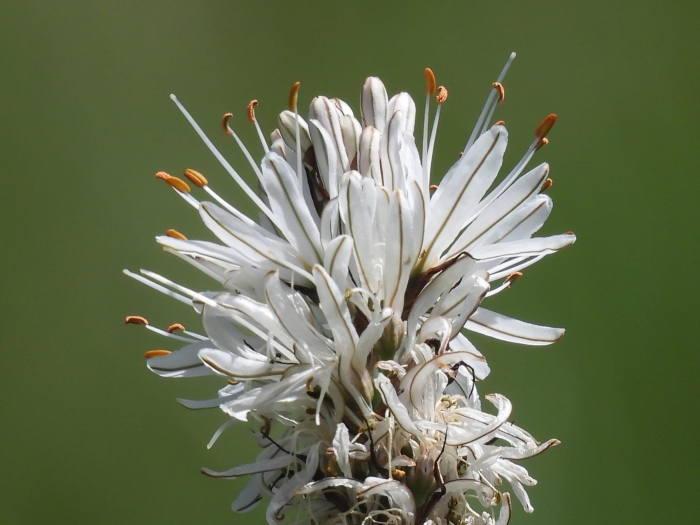White Asphodel
(Asphodelus albus)
White Asphodel (Asphodelus albus)
/
/

© CorentinD
CC BY 4.0
Image By:
© CorentinD
Recorded By:
Copyright:
CC BY 4.0
Copyright Notice:
Photo by: © CorentinD | License Type: CC BY 4.0 | License URL: http://creativecommons.org/licenses/by/4.0/ | Uploader: corentind | Publisher: iNaturalist |






















Estimated Native Range
Summary
Asphodelus albus, commonly known as White Asphodel, is an herbaceous perennial plant native to the Mediterranean region, specifically found in open grasslands, meadows, and rocky areas in central Spain, southwest France, the southern Alps, and the western Balkans, up to elevations of 6,600 feet (2,012 meters). It typically grows to a height of 20-47 inches (50-120 cm) and features a clump of basal, linear, glaucous leaves that give rise to erect flowering stalks. The flowers are white, funnel-shaped, and borne in elongated clusters during the spring and early summer months. They are quite showy and can add a striking visual element to garden settings.
White Asphodel is valued for its striking white blooms and architectural form, making it a good choice for rock gardens, wildflower meadows, and Mediterranean-themed landscapes. It thrives in well-drained soils with a high lime content, reflecting its native calcareous habitats. While it prefers full sun, it can tolerate light shade. White Asphodel is drought-tolerant once established, requiring minimal maintenance. It is not commonly associated with significant diseases or pests, but root rot can occur in poorly drained soils. In ancient Greece, it was associated with mourning and death, and its roots were used as food, indicating its historical significance.CC BY-SA 4.0
White Asphodel is valued for its striking white blooms and architectural form, making it a good choice for rock gardens, wildflower meadows, and Mediterranean-themed landscapes. It thrives in well-drained soils with a high lime content, reflecting its native calcareous habitats. While it prefers full sun, it can tolerate light shade. White Asphodel is drought-tolerant once established, requiring minimal maintenance. It is not commonly associated with significant diseases or pests, but root rot can occur in poorly drained soils. In ancient Greece, it was associated with mourning and death, and its roots were used as food, indicating its historical significance.CC BY-SA 4.0
Plant Description
- Plant Type: Herb
- Height: 2-4 feet
- Width: 1-3 feet
- Growth Rate: Moderate
- Flower Color: White
- Flowering Season: Spring
- Leaf Retention: Deciduous
Growth Requirements
- Sun: Full Sun, Part Shade
- Water: Low, Medium
- Drainage: Fast, Medium
Common Uses
Bee Garden, Border Plant, Low Maintenance, Rock Garden
Natural Habitat
Native to open grasslands, meadows, and rocky areas in the Mediterranean region
Other Names
Common Names: Asfódelo blanco
Scientific Names: , Asphodelus albus, Asphodelus ramosus subsp. albus, Asphodelus ramosus var. albus,
GBIF Accepted Name: